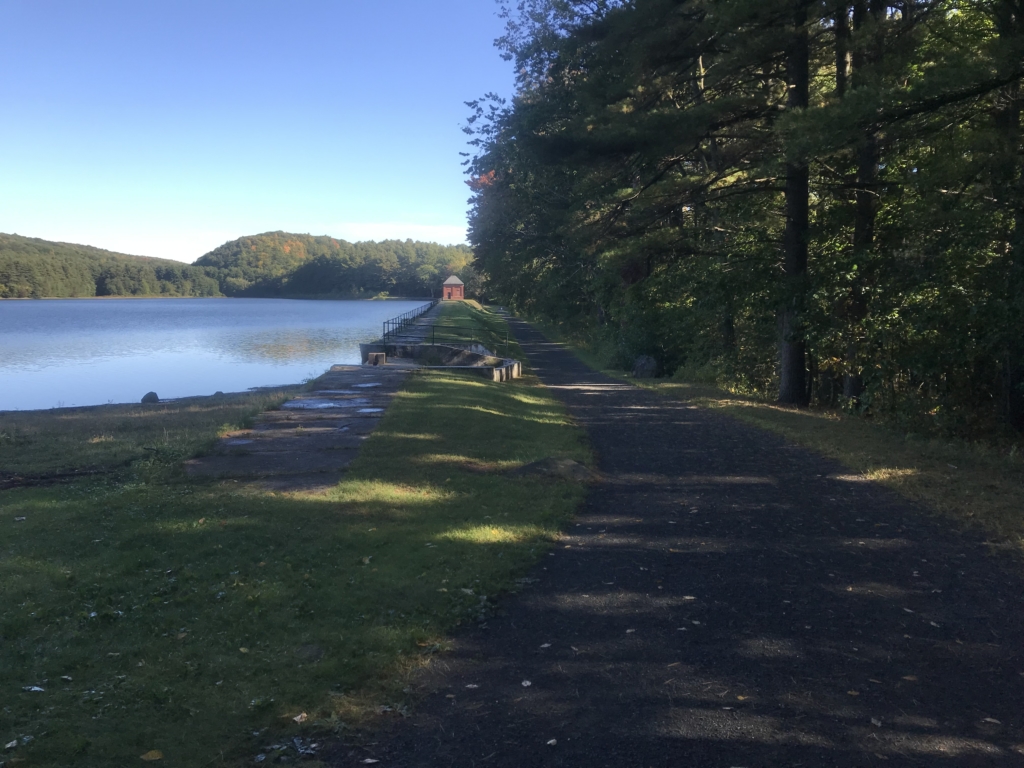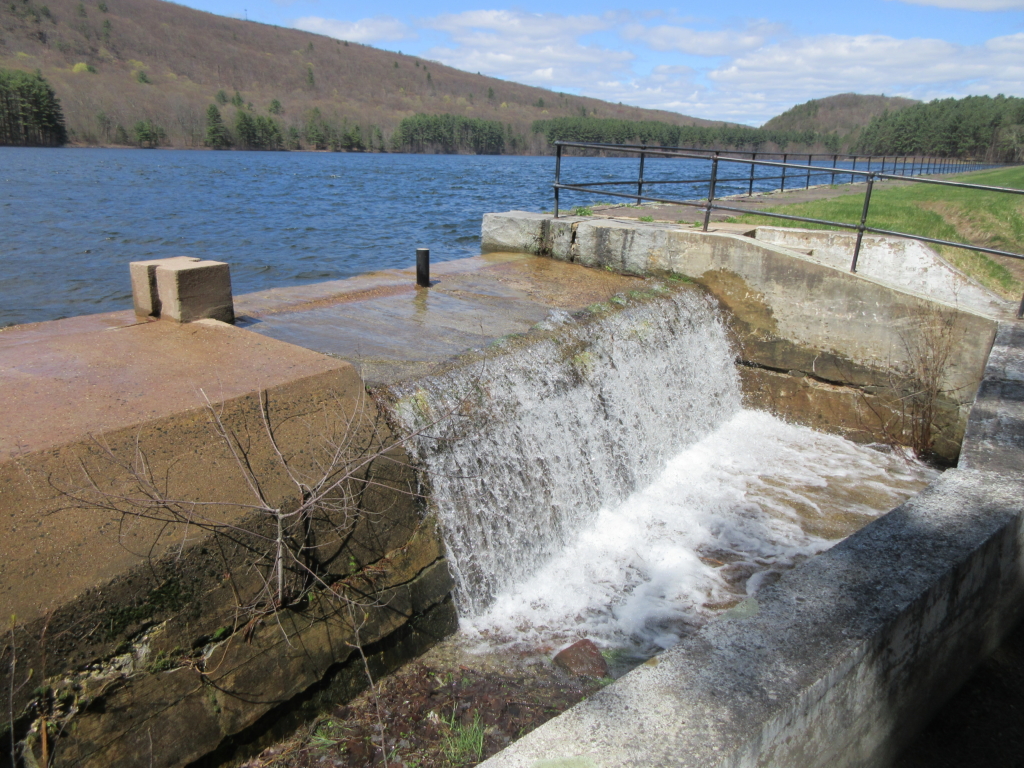Resilient and Reliable Infrastructure – Critical for the City of Holyoke’s Future
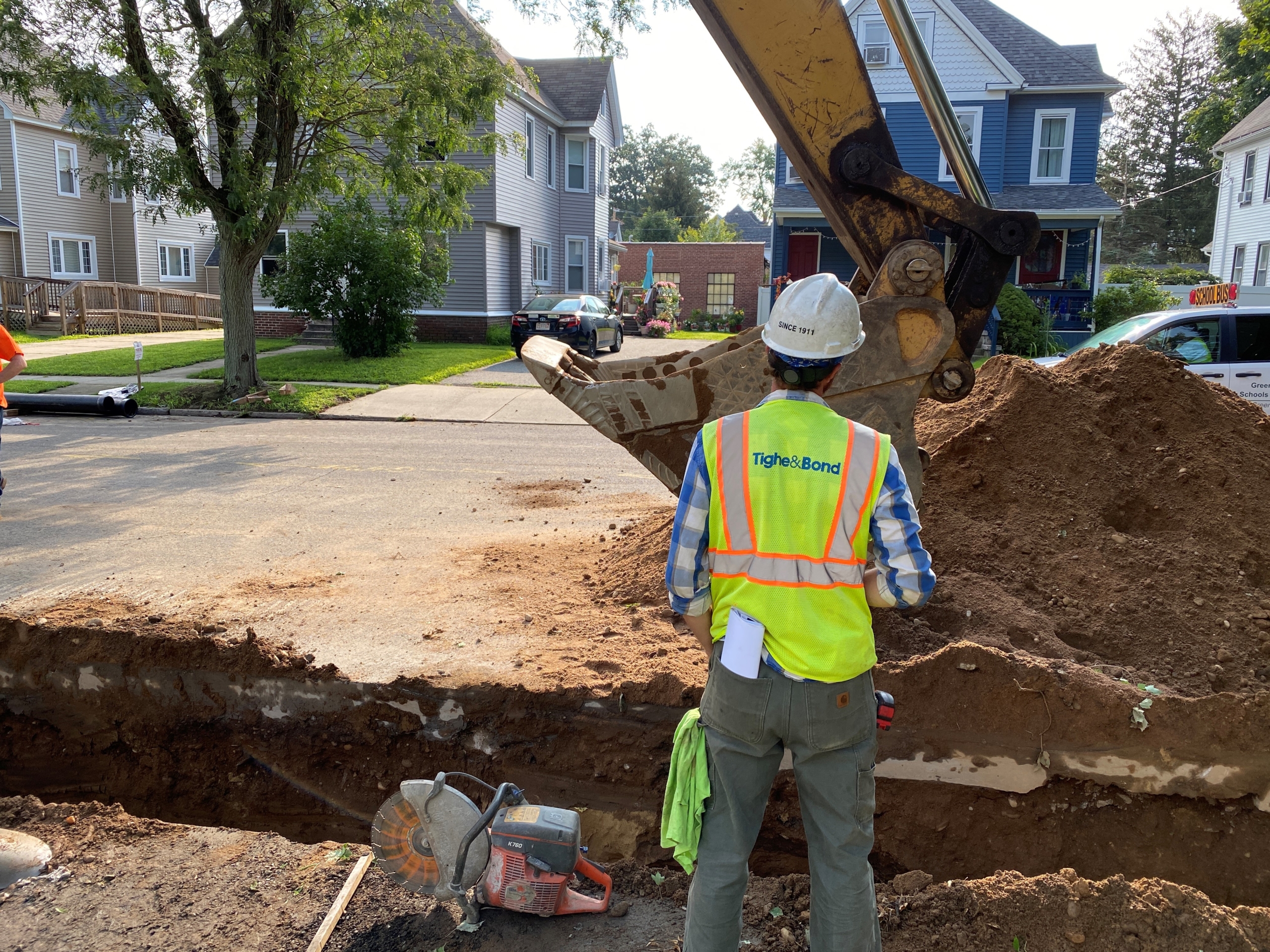
Tighe & Bond oversees the construction phase of water main replacement in Holyoke, MA.
Holyoke Water Works (HWW) received approval for a $13.39 and $6.54 million bond authorization and incremental water rate increases to fund a series of system-wide capital improvement projects that will address deficiencies identified in the municipal water system. Tighe & Bond engineers have become a pivotal partner in HWW’s mission to engineer and provide construction oversight to improve the operation, efficiency, and resiliency of the water system infrastructure for the City of Holyoke.
The history of Tighe & Bond and HWW dates back more than a century ago when our founder James Tighe worked as the city engineer for Holyoke Water Works. He then established Tighe & Bond’s water engineering practice in 1911, working on multiple projects for the city bringing advanced systems and techniques to their practices.
Maintaining the relationship throughout the years, Tighe & Bond and HWW are currently overseeing the construction of multiple bond authorization water system improvement projects. During the previous planning and design phase, the team composed a schedule based on permit allowances to swiftly roll out construction on the water system with total project completion anticipated by the end of 2023.
HWW identified specific parts of the water system infrastructure that require upgrade or replacement due to unsatisfactory conditions or to address capacity limitations. The projects were selected out of a series of categories which ranged from the critical level/high priority to low priority. The projects included water main replacements, a new water storage tank, painting of existing water storage tanks, gatehouse upgrades and a larger capacity reservoir spillway, and discharge channel improvements.
HWW General Manager, David Conti, noted the importance of these capital improvement projects for Holyoke residents and the city’s water infrastructure, “Extending the life of the infrastructure is necessary to provide fire protection and drinking water to the community.” Tighe & Bond has been contracted by HWW to oversee the engineering design, permitting, and bidding of the projects (featured below), and to provide inspection services and administrative oversight during the construction phase of the work.
Water Main Replacements and Improvements
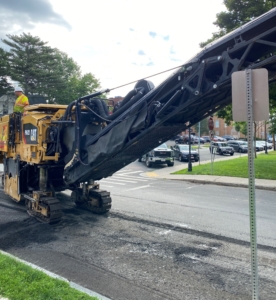
Workers finish paving the road after a new water pipe is installed.
The bond authorization request in the amount of $13.39 million will assign an estimated $6.48 million of the funds for the replacement of approximately 15,800 feet of old, undersized cast iron water pipe with new 8” and 12” ductile iron cement-lined pipe and the installation of approximately 2,100 feet of new 16” water main. These new water pipes will improve fire flow in critical areas of Holyoke. A separate $6.54 million bond authorization was requested specifically to replace an additional 16,050 feet of old, undersized cast iron water pipe with the same ductile iron cement-lined pipe material to improve flow capacity and reduce water quality issues in the public water distribution system. Our team strategically divided the construction into multiple phases in order to keep the water main replacements progressing throughout various areas in the City.
Rehabilitating Existing Steel Water Storage Tanks
Maintenance of existing water storage tanks was also proving to be a high priority among the planned capital improvement projects. HWW solicited Tighe & Bond to research surface preparation methods, prepare design documents, and perform construction oversight for the rehabilitation of five steel water storage tanks including two 3-million-gallon (MG) High Service Tanks, two 2-MG Low Service Tanks, and a single 2-MG West Heights Tank. The tanks are critical infrastructure as they provide potable drinking water, fire protection, and emergency water storage. Maintaining a quality coating is a key component to maximizing the lifespan of any steel tank. The coating protects the tank’s surfaces from deterioration which could lead to structural issues or possibly failure.
The exterior coating systems on the water storage tanks were showing signs of failure including “rust blisters”, chipped or poorly adhered coatings, as well as other surface defects. Four of the tanks, the High and Low Service tanks, were good candidates for spot repairs and surface over-coating since the coating failures were limited to less than 10% of the overall surface. Rehabilitating the coating system is a cost and time-effective way to extend the life of the existing coating system.
The West Heights Tank had a more extensive coating failure and required a full blast method down to the bare metal. The tank was then recoated with a surface primer, intermediate, and final coat epoxy based application. On all five tanks, surface preparation was performed using a wet abrasive blasting method. This method does not create as much dust or debris as traditional abrasive/media blasting and can be performed without a scaffolding and containment system around the tanks when located in isolated or protected areas. Eliminating the need for scaffolding and containment shortened the construction schedule and reduced the cost of the project.
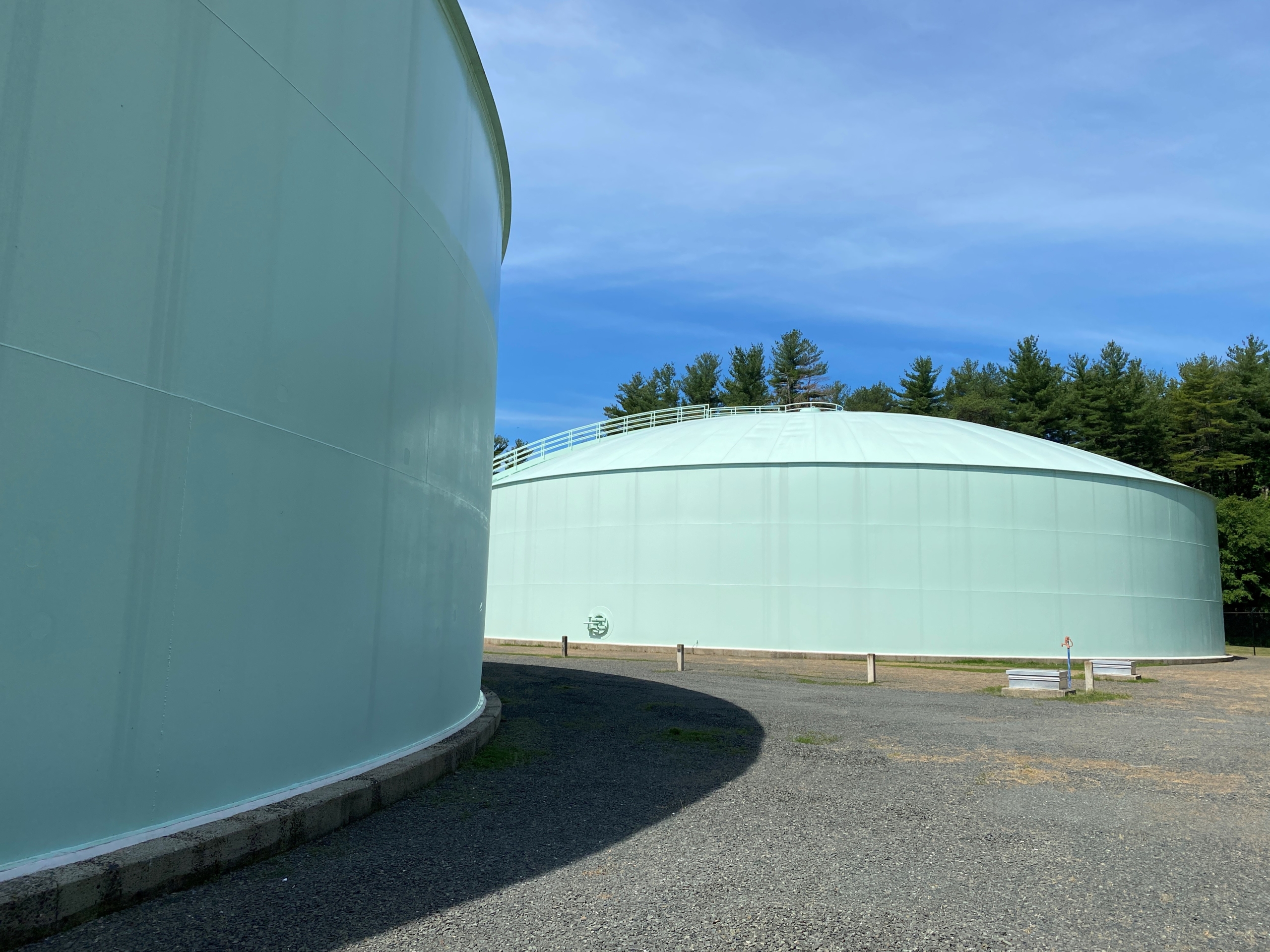
Recently painted steel water storage tanks will help prevent corrosion.
Additional Water Storage in West Holyoke
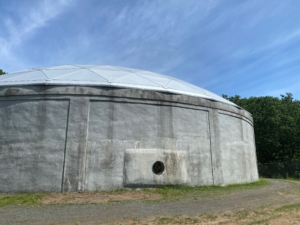
An HWW water storage tank made from prestressed concrete.
The West Holyoke Water system is the only system that does not have a redundant water storage tank. This project will add a second water storage tank to the system, increasing storage and additional system flexibility for operation and maintenance purposes. Prestressed concrete tanks (PCT) were chosen to fulfill the need for redundancy. This type of tank is custom designed and built to the site-specific needs of the proposed tank location. When asked why PCT was the best choice for this portion of the HWW system, Tighe & Bond Staff Engineer Jennifer Reynolds explained, “PCT is considered one of the highest quality and the most durable solutions in portable water storage.”
McLean Reservoir Gatehouse Upgrades
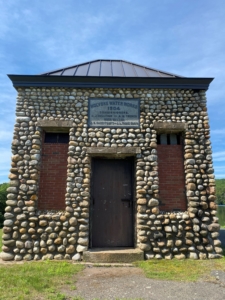
A look at the current McClean Reservoir Gatehouse.
The McLean Reservoir is the City’s primary backup supply to the Tighe-Carmody Reservoir and is also used to supplement HWW’s water system during summer months due to its high water quality. The existing reservoir screening system is currently unable to handle flows necessary to sustain water supply demands when fully operational. In addition, the operation of the gatehouse is labor-intensive and has raised concerns regarding employee safety. This project scope includes replacement of exiting steel screens with lighter stainless steel screens; installation of a new screen wash system and electric hoist for safer/easier cleaning maintenance; replacement of the sluice gate; as well as other structural, mechanical, and electrical improvements to the building.
Reconstruction of Whiting Street Reservoir Spillway and Discharge Channel
HWW and Tighe & Bond are working toward the replacement and expansion of the Whiting Street Reservoir Spillway and Discharge Channel. The Whiting Street Reservoir Dam is a stone masonry and earthen embankment dam that is approximately 1,900 feet long and 19 feet high. Tighe & Bond completed a hydrologic and hydraulic analysis which indicated that the dam does not meet the Massachusetts Dam Safety Regulations for spillway capacity of a high hazard potential dam. Our team of engineers is providing HWW with design engineering, permitting, bidding, and construction phase services for repairs and remedial action for the dam. The project will replace the existing spillway with a new, larger spillway, capable of meeting the spillway capacity requirements as well as upgrades to the immediate portion of the downstream discharge channel. Two culverts will be installed on the northeast side of the new spillway beneath the gravel access road to discharge the majority of the spillway flow, and will outlet to the stream located downstream of the spillway. To limit erosion and withstand heavy flows, the portion of the stream located downstream of these two culverts will be stabilized using a combination of rubble placement and cross-vanes.
“As engineers, it’s our job to ensure that our clients and their communities have access to critical water systems. As the capital improvement projects at Holyoke Water Works progress, their leaders and our engineers are assisting the City of Holyoke with providing residents safe and reliable water infrastructure for years to come,” says Peter Grabowski, Tighe & Bond’s Water Business Line Leader.
- Left and Right: Tighe & Bond captured images of the current state of the dam.



